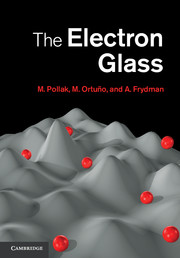Book contents
- Frontmatter
- Contents
- Acknowledgments
- List of symbols
- 1 Introduction
- 2 Disordered electronic systems
- 3 Basics of glasses
- 4 Equilibrium properties of the electron glass
- 5 dc Conductivity
- 6 Other transport properties of electron glasses
- 7 Glassy behavior
- 8 Relationship to other glasses
- 9 Open issues
- References
- Index
9 - Open issues
Published online by Cambridge University Press: 05 January 2013
- Frontmatter
- Contents
- Acknowledgments
- List of symbols
- 1 Introduction
- 2 Disordered electronic systems
- 3 Basics of glasses
- 4 Equilibrium properties of the electron glass
- 5 dc Conductivity
- 6 Other transport properties of electron glasses
- 7 Glassy behavior
- 8 Relationship to other glasses
- 9 Open issues
- References
- Index
Summary
The previous chapters described the unusual electronic phenomena brought about by disorder and interaction and how they can be understood at least qualitatively. To conclude this book, a number of open questions and possible future research directions are addressed. These demonstrate that the field of electron glass is far from being closed and that some of its major issues are not understood or are under debate. First and foremost, there exists no statistical or thermodynamic theory of nonergodic systems, and for that reason there is no full understanding of any glasses – less so of quantum glasses such as is the electron glass. Indeed, the purpose of this book is to present a comprehensive review of the current state of the field, with the anticipation that further experimental, theoretical, and numerical work will follow and help elucidating the issues that remain unclear today.
• Processes responsible for glassy properties At the present, there is no consensus as to the electronic processes that lead to long relaxation and memory phenomena. Does the glassy behavior require many-electron transitions or are single hops enough? Is it only very low energy transitions that linger at very long times? The proposed suggestions for the slow relaxation of conductivity are slow formation of the Coulomb gap, slow formation of quasi-particles, slow manyelectron transitions off the percolation path affecting the paths, many-electron transitions traversing the current carrying path, exchange of particles between the percolation path and clusters off the path, all as discussed in Chapter 7.
- Type
- Chapter
- Information
- The Electron Glass , pp. 264 - 268Publisher: Cambridge University PressPrint publication year: 2012

